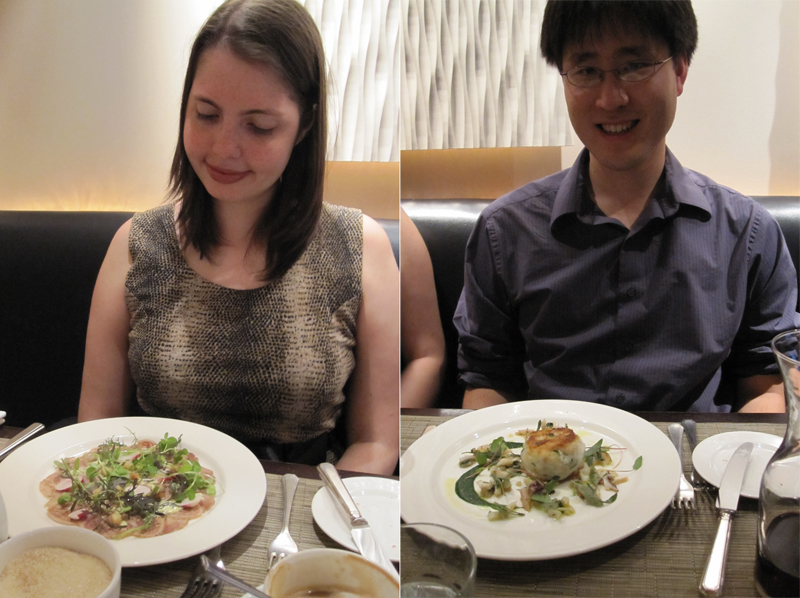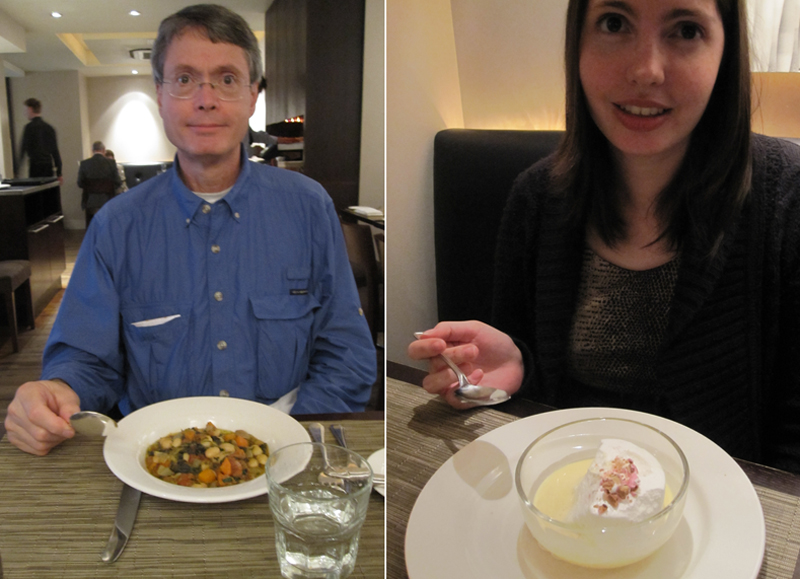The Thames is to the south, and you can see how the Millennium foot bridge leads to the Tate Modern (the old power plant with a tall smoke stack that's now a big modern art museum with a tall tower).
Halfway to the bridge, you can see one of the Big Bus tour buses. Just under a block to the right of the bus is the Church of St Benet Paul's Wharf, one of Christopher Wren's churches. It's the one with the dark pointed roof above a rectangular white-framed window. We didn't visit it, but I learned just today that it's designated as the City's Welsh church, with services conducted in Welsh.
We're now at the highest accessible vantage point in the Cathedral, the Golden Gallery. This view to the west includes the twin towers flanking the front of the Cathedral, and the urban canyon of Ludgate Hill, which become Fleet Street a bit farther east.
Our hotel is partly visible behind the main part of the tower on the right. It's the modern-looking 7-story structure.
Between the hotel building and the right tower is a curving older looking building that houses the Marks & Spencer Simply Food store where I got several helpings of porridge (ready-made oatmeal) during the week.
To the southwest, we can see two bridges. The nearer one is a railroad bridge, and the one right next to it is the Blackfriars Bridge. On this end of the bridge there's a Tube station that's quite close to our hotel but, unfortunately, it was closed for refurbishing while I was there.
Along the skyline just to the right of the middle of the picture you can see the London Eye that we rode on my first day in London.
London streches off into the distance to the northwest. The minaret-like tower piercing the skyline left of the middle is the British Telecom Tower, and bristles with antennas.
Nearer the left edge of the picture, below the skyline near Fleet Street, is the wedding cake tower of St. Bride's Church.
The Gherkin is in the middle of this view to the east, above the construction zone.
In the haze much farther to the east are some tall buildings in the Docklands area, which is rapidly developing out of the old Port of London and which will be the location of much of the 2012 Olympics.
And again to the southwest, along the Thames as it approaches the Westminster area.
Many hands have held onto that railing over the years. There isn't much space between the railing and the wall, so the railing gets a lot of use.
To the west, this closeup from the Golden Gallery includes the wedding cake tower of St. Bride's Church reaching from below the middle of the picture to the top.
There are many other church towers in the City, many of them hard to see when looking straight down from above, and even harder to see from the street canyons.
I went on to the Museum of London, just north of St. Paul's Cathedral. If I had stayed on the right road it would have taken only a few minutes to get there.
There was construction going on around the entrance, but eventually I found my way in.
There were many artifacts in the museum that were recoved from digs within a few miles of the museum itself.
This floor mosaic was unearthed in 1976 on Milk Street, about a quarter of a mile from the Museum.
I rushed through the exhibits, which included informative displays and film clips in addition to the artifacts, because the thing I most wanted to see was just outside.
The Worhipful Company of Barbers is no longer associated with barbers. It is primarily a charitable organization helping medical and surgical causes.
From the Museum of London I walked back south. I didn't get lost this time, since I could just walk toward St. Paul's Cathedral.
I continued south past St. Paul's to the Millennium Bridge. Just before the Bridge, I turned around and took this picture of St. Paul's to the north.
Walking on to the Millenium Bridge, I approached the Tate Modern.
What gorgeous weather! I hadn't bothered to pack my sunglasses, since everyone knows it's always cloudy and wet in London.
I walked back to the hotel, and caught up with Jennifer and Winston. Winston took us to a restaurant he wanted to try, Arbutus.
The food at the Michelin-starred Arbutus was both beautiful and tasty. Jennifer had thinly sliced lamb and smoked eel risoto, and Winston had a squid & mackerel burger.


After dinner we took the Tube to the Victoria Station. Looking around for the right direction in which to proceed, we saw the Apollo Victoria Theatre right across the street. The lobby was very crowded, and the line to pick up the tickets for the seats Winston had reserved online was slow-moving, but we were in plenty of time to get to our seats.
The set was amzaing, with intricate machinery and places for characters to climb and perch on the sides.
And high above the stage was a dragon, whose head moved and wings flapped, powered by men at the sides discretely pulling on ropes.
The singing was powerful, and the story (The Wizard of Oz from the viewpoints of the witches) was a compelling and often fun study of how one's obvious assumptions can be wrong.
It was an exciting end to another wonderful day.